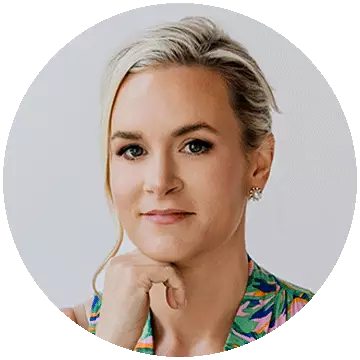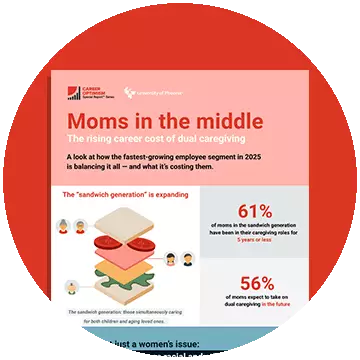The truth about the sandwich generation

Written by Laurie Davies

Moms never clock out. That’s a given. But sandwich generation moms far exceed the boundaries of 9-to-5 employment. It’s more like 5-to-9 endurance training. Every day. And even when 9 p.m. hits, there are just a few more emails to return, prescriptions to pick up or, ahem, sandwiches to make.
At increasing rates, “sandwich moms” — that is, moms who are simultaneously caring for their children and aging loved ones — are also feeling the squeeze in their careers. In fact, some feel squeezed out of their careers.
These moms in the middle have ambition and they’re exhausted. They’re digital natives yet they’re trying to unplug from always-on work expectations. They’re using paid time off for caregiving, not R&R. According to the 2025 Career Optimism Special Report™ Series: Moms in the Sandwich Generation, 4 in 10 (37%) are scared to talk about caregiving responsibilities at work. A majority (59%) feel that being a caregiver has held them back in their careers, and 40% say they feel ostracized at work due to caregiving responsibilities.
Last month, the University of Phoenix Career Institute® and Motherly, a platform that connects modern mothers with articles, products, classes and advocacy, released the report, Moms in the Sandwich Generation. Findings show it’s rough out there for dual-caregiving moms.
But there’s room for hope and action.
We recently sat down with Liz Tenety, co-founder of Motherly, to unpack the report’s findings, discuss a path forward and, as it turns out, discover how close the report’s findings hit home for her. If you’re a sandwich mom or one of the 56% who soon expects to be, read on to discover the facts — and to find strategies for how to navigate these new realities on your terms.
Why study the sandwich generation?
At Motherly, which has upward of 75 million multiplatform audience viewers each month, Tenety has a vested interest in delivering women-centric content helpful to modern moms, not just those in the sandwich generation.

Liz Tenety
Co-founder of Motherly
But she’s also a mom of five — ages 2, 5, 8, 11 and 12 — with two sets of aging parents who plan to relocate nearby as they move into their senior years. Tenety is staring dual caregiving in the face.
“I feel myself shifting from this grind mentality of working and momming. I’m not slowing my career down, but I am in a way slowing myself down. It feels like new pressures are coming. When my kids are growing and maybe need me less, my parents will need me more,” she says.
Her situation aligns with the data. In the last 50 years, the average age of first-time motherhood has gone up by seven to eight years. “That means today’s moms are having children later — and at the same time, their own mothers are also older,” Tenety says. “This creates a new reality: Many moms are caring for young kids while also needing to support aging parents.”
Now, many families are stretched between two generations who need care — young children and aging grandparents — at the same time.
Unsurprisingly, the results of this year’s report are personal for Tenety. They are also personal for millions of working mothers. Don’t get Tenety started on the fact that the term “working mothers” is even a thing. Or that, according to the report, 51% of sandwich moms have already left a job due, at least in part, to caregiving.
A paid job, that is.
“The caregiving work that mothers do in society is often known as invisible labor,” Tenety says. “Caregiving is something that society [pays] a lot of lip service to, but a look at many employer policies toward caregiving shows a disconnect. In order to get to a place where caregiving is valued, we need to have data, insights and an ability to tell the story of what this generation is up against.”
By “this generation,” she largely means millennials who are in the thick of caregiving years. The number of people age 65 and older is projected by Population Reference Bureau to rise from 58 million in 2022 to 82 million by 2050 — a 47% increase. And, as millennials enter the caregiving arena, many will do so with much younger children than previous sandwich generations. The mean age for giving birth was 27.4 years old in 2022, a record high for the nation and up from 21.4 in 1970, according to the Centers for Disease Control and Prevention.
Put it together and it means that more working women with young children will be caring for record numbers of aging parents in the years to come. Something is going to have to give. Hopefully, it won’t be the moms.
Sandwich stats
The Moms in the Sandwich Generation report contains sobering statistics. For example, among sandwich moms:
- 64% of their sick time and/or PTO is spent on caregiving.
- 58% turn down educational opportunities due to caregiving roles.
- 46% say their caregiving responsibilities negatively affected their career progression.
- 29% report feelings of isolation due to caregiving responsibilities.
As one mom who was interviewed for the report confessed, “Self-care is last. Always.”
Yet millennial women participate in the workforce more than any other generation of women. By sheer numbers, they may help turn the tide. Tenety says men have an important role in all of this, too, both as proud egalitarian caregivers and as vocal proponents of workplace change.
“Women are craving work-life integration. That feels more in line with this generation’s values,” Tenety says. As more women rise into leadership positions, she says, caregiving values may also rise beyond lip service. “As you rise, you’re in position to reshape the culture of the team you’re building. This is a very hopeful position for our generation of ambitious women who need to redefine what caregiving looks like.”
Solutions for the sandwich generation
Tenety remains convinced that today’s working moms will not only champion family health, but they will also help redefine outdated workplace norms that are inflexible or penalize women who value work and caring for family members. Tenety says there are several things today’s women can do to turn the tide for the sandwich generation:
- Seek employers that offer generous PTO/paid sick leave policies and a child care stipend.
- Before entering the sandwich generation, position yourself by upskilling or going back to school.
- Advocate for policy shifts that champion caregiving.
- Think entrepreneurially. If workplaces won’t work with you, consider working for yourself as a freelancer, contractor or small business owner.
- Make a case for remote work to your employer.
In a post-pandemic era that has some employers growing less flexible on remote work, Tenety urges sandwich moms to lobby for it anyway. “Frame it as a win-win, first with the needs of the job in mind,” she says. “You can get more work done if you’re not commuting. And it’s not just time, but it’s frustrating, expensive time that we are investing in child care. Much of that lost time could be reinvested in productivity.”
Also, make an empirical case that you’re more committed, not less committed. The opposite is a common belief that feeds into the motherhood penalty, a phenomenon that results in lower pay, fewer promotions and a perceived lack of commitment in the workplace.
“Just ask your employer: ‘Could we try it for a month and see where it goes?’ Then, overdeliver for that month. Really get it done,” Tenety says.
In the end, a shift toward creating a culture that celebrates caregiving is the much bigger picture.

“The report showed that more than half of moms anticipate soon being in dual caregiving roles. This is not a niche issue. In our culture, we think of child care as a very short period of time. It’s a decades-long marathon,” Tenety says.
As the Moms in the Sandwich Generation report shows, sandwich moms already feel greater degrees of stress, frustration and isolation than non-sandwich moms.
American workplaces can’t afford to have an educated, competent, flexible, tech-savvy segment of the workforce feeling burned out — or locked out — of careers.
As boomers retire in greater numbers — creating job openings in an already talent-squeezed workforce — now is the time for sandwich moms to foster competition by choosing workplaces that offer greater flexibility.
At the end of the day, it won’t be just moms who win. Employers will win. Families will win. Communities will win. “Caregiving is deeply human, and respectful, and wise,” Tenety says. “Caring for one another is the most essential work of all.”
Moms in the Sandwich Generation Report
The Career Optimism Special Report™ Series: Moms in the Sandwich Generation, reveals critical insights on the career cost of dual caregiving and the imperative for increased employer support to serve the fastest-growing employee segment in the U.S.

Learn more about the report’s findings below, or read the full Moms in the Sandwich Generation report.

ABOUT THE AUTHOR
A journalist-turned-marketer, Laurie Davies has been writing since her high school advanced composition teacher told her she broke too many rules. She has worked with University of Phoenix since 2017, and currently splits her time between blogging and serving as lead writer on the University’s Academic Annual Report. Previously, she has written marketing content for MADD, Kaiser Permanente, Massage Envy, UPS, and other national brands. She lives in the Phoenix area with her husband and son, who is the best story she’s ever written.
This article has been vetted by University of Phoenix's editorial advisory committee.
Read more about our editorial process.


